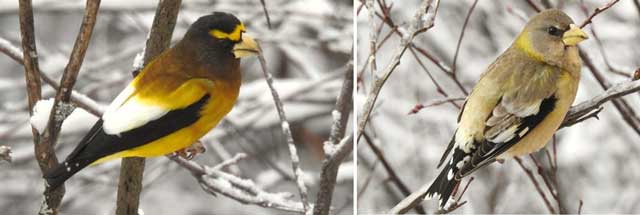Evening grosbeak
Scientific name: Coccothraustes vespertinus

Photo credit: bkinder832 CC 4.0 International Public License
Status
Special Concern
“Special Concern” means the species lives in the wild in Ontario, is not endangered or threatened, but may become threatened or endangered due to a combination of biological characteristics and identified threats.
Date added to the Species at Risk in Ontario List
August 1, 2018
What it looks like
The Evening Grosbeak is a member of the Fringillidae family of songbirds. It is a large, stocky finch with a thick greenish-yellow bill. Adult males are yellow and black in colour with a prominent white patch on the wings and a brown head. Females and juveniles are mostly greyish-brown, with white and black wings and some yellow on the neck and flanks.
Where it lives
During the breeding season, the Evening Grosbeak is generally found in open, mature mixed-wood forests dominated by fir species, White Spruce and/or Trembling Aspen. Its abundance is strongly linked to the cycle of its primary prey, the Spruce Budworm. Outside the breeding season, the species depends mostly on seed crops from tree species in the boreal forest such as firs and spruces. It is also attracted to ornamental trees that have seeds or fruit, and may visit bird feeders.
Where it’s been found in Ontario
The Evening Grosbeak is found in all Canadian provinces and territories except Nunavut. In Ontario, it breeds in coniferous forests across northern Ontario, as far south as southern Georgian Bay. It is estimated that there are roughly 500,000 adult birds in Ontario.
What threatens it
Potential threats to the Evening Grosbeak include habitat loss and degradation from forestry practices, chemical measures to control Spruce Budworm populations and climate change impacts. Collisions with vehicles while flying over roads or ingesting salt along roadsides and hitting windows near bird feeders have also been identified as threats.
It is thought that the decline in populations since the 1970s is correlated with the 25-40 year natural cycle of the Spruce Budworm.
Actions we are taking
Special concern species do not receive species or habitat protection, but may be eligible for grants to help with their protection and recovery.
What you can do
Report a sighting
- Report a sighting of an endangered animal or plant to the Natural Heritage Information Centre. Photographs with specific locations or mapping coordinates are always helpful.
- Bird Studies Canada is working to advance the understanding, appreciation and conservation of wild birds and their habitat in Ontario and elsewhere; for more information on how you can help, visit: bsc-eoc.org.
- As with all wildlife, don’t disturb or harass the birds or nesting sites. Be respectful and observe from a distance.
Volunteer
- Volunteer with your local nature club or provincial park to participate in surveys or stewardship work focused on species at risk.
Be a good steward
- Private land owners have a very important role to play in species recovery. If you find Evening Grosbeak on your land, you may be eligible for stewardship programs that support the protection and recovery of species at risk and their habitats.
Report illegal activity
- Report any illegal activity related to plants and wildlife to
1-877-TIP-SMNR (847-7667) .
Quick facts
- This species is a major predator of the Spruce Budworm and helps control populations of this pest in the summer.
- Evening Grosbeak are often found along roadsides consuming road salt and grit, increasing the risk of collisions with vehicles.
- During the breeding season, they may nest in small groups or loose colonies as the species is not territorial.